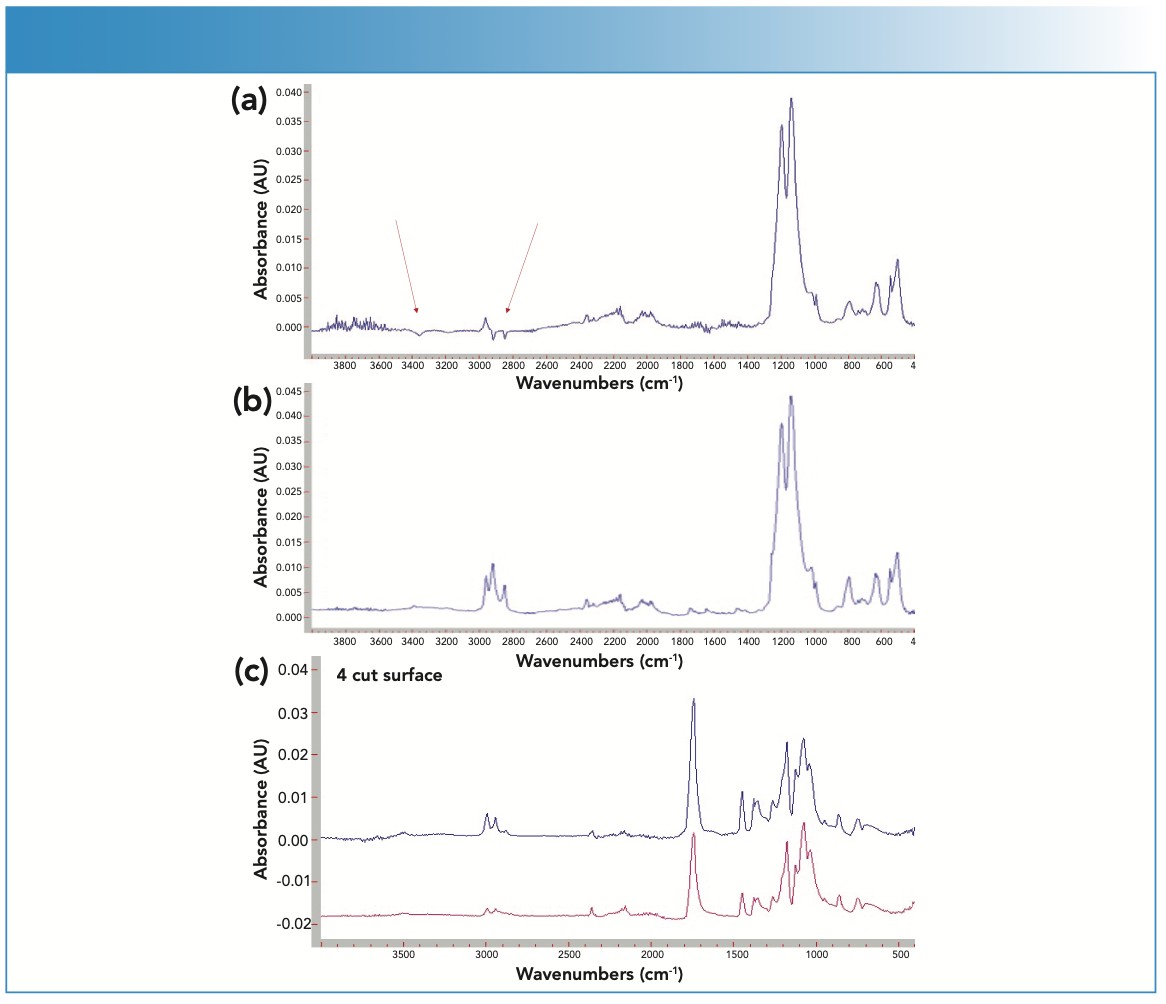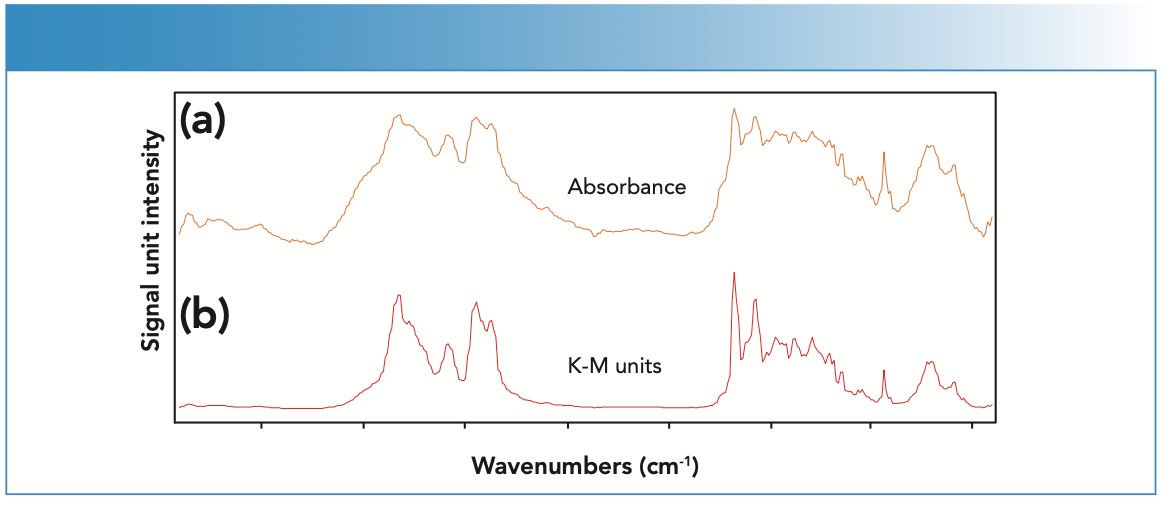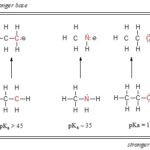FTIR-ATR data and FTIR diffuse reflectance are both valuable spectroscopic techniques, but can you compare them directly? COMPARE.EDU.VN offers a comprehensive breakdown, providing clarity for researchers and analysts alike. This article explores the nuances of each method, highlighting their strengths, limitations, and the critical considerations for data interpretation, ensuring you make informed decisions. Learn the difference between surface analysis and bulk material characterization using these techniques, and understand the implications of spectral data processing.
1. Understanding FTIR-ATR Spectroscopy
FTIR-ATR (Fourier Transform Infrared – Attenuated Total Reflectance) spectroscopy is a surface-sensitive technique used to identify and analyze materials based on their infrared absorption spectra. It’s particularly useful for analyzing solids, liquids, and even thin films without extensive sample preparation.
1.1 What is Attenuated Total Reflectance (ATR)?
ATR works by pressing a sample against an internal reflection element (IRE), such as a crystal made of zinc selenide (ZnSe), germanium (Ge), or diamond. An infrared beam is passed through the IRE, and at each interface between the crystal and the sample, total internal reflection occurs.
During this process, an evanescent wave penetrates a short distance (typically 0.5 to 5 micrometers) into the sample. The evanescent wave interacts with the sample, and certain frequencies of the IR radiation are absorbed by the sample’s molecules, depending on their vibrational and rotational energies. The attenuated (weakened) radiation is then detected, and the resulting spectrum provides information about the sample’s composition.
1.2 Advantages of FTIR-ATR
- Minimal Sample Preparation: ATR requires very little sample preparation, making it a quick and convenient technique.
- Versatility: It can be used for solids, liquids, powders, and pastes.
- Surface Sensitivity: ATR is highly sensitive to the surface composition of the sample.
- Non-Destructive: The technique is generally non-destructive, preserving the sample for further analysis.
1.3 Limitations of FTIR-ATR
- Surface Contamination: The results are highly influenced by surface contaminants. A dirty ATR element will skew the results.
- Pressure Sensitivity: Good contact between the sample and the IRE is essential, requiring pressure that can sometimes distort soft samples.
- Limited Penetration Depth: ATR probes only the surface of the sample, potentially missing information about the bulk material.
2. Exploring FTIR Diffuse Reflectance Spectroscopy
FTIR diffuse reflectance spectroscopy, also known as DRIFTS (Diffuse Reflectance Infrared Fourier Transform Spectroscopy), is a technique used to analyze powdered, rough, or opaque samples. Unlike ATR, diffuse reflectance probes deeper into the sample, providing information about the bulk material composition.
2.1 How Does Diffuse Reflectance Work?
In diffuse reflectance, infrared radiation is directed onto the sample surface. The radiation penetrates the sample, scatters in multiple directions, and a portion of the scattered radiation is collected by the detector.
The collected radiation includes both specular (surface) reflectance and diffuse reflectance, which originates from within the sample. The diffuse reflectance component carries information about the sample’s absorption characteristics.
2.2 Advantages of FTIR Diffuse Reflectance
- Bulk Material Analysis: Diffuse reflectance provides information about the overall composition of the sample, not just the surface.
- Suitable for Powders: It’s ideal for analyzing powders and materials with rough surfaces.
- Less Sensitive to Surface Contact: Unlike ATR, it doesn’t require intimate contact between the sample and the instrument.
2.3 Limitations of FTIR Diffuse Reflectance
- Sample Preparation: Requires careful sample preparation, including mixing the sample with a non-absorbing matrix like potassium bromide (KBr).
- Scattering Effects: Scattering can complicate data interpretation, especially for highly scattering samples.
- Spectral Distortions: Can suffer from spectral distortions if not processed correctly using Kubelka-Munk transformations.
3. Key Differences Between FTIR-ATR and FTIR Diffuse Reflectance
The following table summarizes the key differences between FTIR-ATR and FTIR diffuse reflectance spectroscopy:
| Feature | FTIR-ATR | FTIR Diffuse Reflectance |
|---|---|---|
| Sampling Technique | Attenuated Total Reflectance | Diffuse Reflectance |
| Surface/Bulk | Surface-sensitive | Bulk-sensitive |
| Sample Preparation | Minimal | More extensive (e.g., KBr mixing) |
| Sample Type | Solids, liquids, powders, thin films | Powders, rough surfaces, opaque materials |
| Penetration Depth | Shallow (0.5-5 μm) | Deeper, depends on scattering properties |
| Contact Requirement | Requires good contact with IRE | Less sensitive to surface contact |
| Data Processing | Simpler | Requires Kubelka-Munk correction for accuracy |


4. Can You Directly Compare FTIR-ATR Data to FTIR Diffuse Reflectance?
Direct comparison of FTIR-ATR and FTIR diffuse reflectance data is generally not recommended without careful consideration and processing. Here’s why:
4.1 Differences in Sampling Depth
ATR probes the surface, while diffuse reflectance analyzes the bulk. If the surface composition differs significantly from the bulk, the spectra will be different. For instance, plasticizers migrating to the surface or oxidation effects can create discrepancies.
4.2 Matrix Effects
In diffuse reflectance, the sample is often diluted in a non-absorbing matrix like KBr. This dilution can affect the band intensities and shapes compared to ATR, where the sample is measured neat (in its pure form).
4.3 Spectral Distortions
Diffuse reflectance spectra can be distorted due to scattering effects. The Kubelka-Munk transformation is essential to correct these distortions, but it’s an approximation and may not perfectly compensate for all scattering effects.
4.4 Refractive Index Effects
ATR spectra are influenced by the refractive index of both the sample and the ATR crystal. This can lead to band shifts and intensity variations compared to transmission or diffuse reflectance spectra.
4.5 Instrument and Accessory Variations
Different FTIR instruments and accessories can have varying optical properties, which can affect the recorded spectra. Careful calibration and standardization are necessary to minimize these effects.
5. When and How to Compare FTIR-ATR and Diffuse Reflectance Data
Despite the challenges, there are situations where comparing ATR and diffuse reflectance data can be valuable:
5.1 Assessing Surface vs. Bulk Differences
Comparing ATR and diffuse reflectance spectra can help identify differences between the surface and bulk composition of a material. For example, in polymer films, you can detect surface oxidation or migration of additives.
5.2 Qualitative Comparisons
If you’re primarily interested in identifying the presence of specific compounds, you can compare the peak positions in ATR and diffuse reflectance spectra. However, be cautious about interpreting intensity differences without proper corrections.
5.3 Quantitative Analysis
For quantitative analysis, it’s best to calibrate each technique separately using appropriate standards. If you want to relate the results from both techniques, you’ll need to develop a correlation model that accounts for the differences in sampling depth, matrix effects, and spectral distortions.
5.4 Steps for Meaningful Comparison
- Data Processing: Ensure that both ATR and diffuse reflectance data are properly processed. This includes baseline correction, atmospheric compensation, and Kubelka-Munk transformation for diffuse reflectance.
- Normalization: Normalize the spectra to a common band or area to account for differences in sample concentration or pathlength.
- Spectral Subtraction: Subtract the spectra to highlight differences between the surface and bulk.
- Multivariate Analysis: Use multivariate techniques like principal component analysis (PCA) to identify and quantify the factors that contribute to the differences between the two techniques.
6. Practical Examples and Applications
6.1 Polymer Film Analysis
In the analysis of polymer films, ATR can be used to assess the surface composition, while diffuse reflectance can characterize the bulk material. By comparing the spectra, you can identify the presence of additives or degradation products on the surface.
For example, if the ATR spectrum shows a higher concentration of carbonyl groups (C=O) than the diffuse reflectance spectrum, it could indicate surface oxidation.
6.2 Pharmaceutical Powders
For pharmaceutical powders, diffuse reflectance is often used to quantify the concentration of active pharmaceutical ingredients (APIs) in a formulation. ATR can be used to verify the identity of the API and excipients, but it may not be suitable for quantitative analysis due to its surface sensitivity.
6.3 Cultural Heritage
In the field of cultural heritage, FTIR-ATR and diffuse reflectance can be used to analyze the composition of paints, pigments, and coatings on artifacts. ATR can provide information about the surface layers, while diffuse reflectance can probe deeper into the material to identify underlying layers or the original composition.
7. Overcoming Challenges in Data Interpretation
7.1 Surface Sensitivity Issues
To minimize the impact of surface contamination in ATR, clean the ATR crystal thoroughly before each measurement. If you suspect surface oxidation or other surface effects, gently abrade the surface to expose the underlying material.
7.2 Scattering Effects in Diffuse Reflectance
To reduce scattering effects in diffuse reflectance, use a fine particle size for the sample and ensure that it’s uniformly mixed with the KBr matrix. Use appropriate scattering correction algorithms in your data processing software.
7.3 Spectral Artifacts
Be aware of potential spectral artifacts, such as water vapor bands or carbon dioxide bands. These artifacts can be minimized by purging the instrument with dry air or nitrogen and using appropriate background correction techniques.
7.4 Data Processing Software
Utilize data processing software capable of performing advanced spectral manipulations, such as baseline correction, normalization, Kubelka-Munk transformation, and spectral subtraction.
8. Future Trends in FTIR Spectroscopy
8.1 Advanced Data Analysis
The use of machine learning and artificial intelligence (AI) is becoming increasingly prevalent in FTIR spectroscopy. AI algorithms can be trained to identify subtle spectral features, classify materials, and predict sample properties with high accuracy.
8.2 Hyperspectral Imaging
FTIR hyperspectral imaging combines FTIR spectroscopy with imaging techniques to acquire spectra at each pixel of an image. This allows for the spatial distribution of chemical components to be mapped, providing valuable information about the heterogeneity of materials.
8.3 Portable FTIR Instruments
Portable FTIR instruments are becoming more compact and affordable, making them suitable for on-site analysis in a wide range of applications, such as environmental monitoring, food safety, and quality control.
9. Expert Tips for Accurate FTIR Analysis
- Calibration is Key: Always calibrate your FTIR instrument regularly using appropriate standards.
- Background Matters: Collect a background spectrum before each measurement to compensate for instrument and environmental effects.
- Resolution Settings: Optimize the spectral resolution to balance sensitivity and resolution.
- Cleanliness Counts: Keep your optics, ATR crystals, and sample holders clean to minimize contamination.
- Reference Spectra: Compare your spectra to reference libraries to aid in compound identification.
10. Case Studies: Comparing FTIR-ATR and Diffuse Reflectance in Research
10.1 Analysis of Microplastics in Environmental Samples
Researchers used both FTIR-ATR and diffuse reflectance to analyze microplastics collected from river sediments. ATR was used to identify the polymer types on the surface of the microplastics, while diffuse reflectance was employed to quantify the overall concentration of microplastics in the sediment samples.
10.2 Quality Control of Food Packaging Materials
A food packaging company used FTIR-ATR to verify the surface coating of their packaging films, ensuring that it met regulatory standards for food contact materials. Diffuse reflectance was used to check the bulk composition of the films, ensuring that they were free from contaminants.
10.3 Forensic Analysis of Paint Samples
Forensic scientists used FTIR-ATR and diffuse reflectance to analyze paint samples collected from crime scenes. ATR was used to identify the topcoat layer, while diffuse reflectance was used to analyze the primer layer and compare it to reference paints.
11. Conclusion: Making Informed Decisions with FTIR Data
While directly comparing FTIR-ATR and diffuse reflectance data can be challenging, understanding the strengths and limitations of each technique allows for valuable insights into material composition. By carefully considering sampling depth, matrix effects, and spectral distortions, you can effectively combine data from both techniques to gain a more comprehensive understanding of your samples. COMPARE.EDU.VN is your resource for objective comparisons, empowering you to make well-informed decisions.
12. FAQs About Comparing FTIR-ATR and Diffuse Reflectance Data
12.1 Can I use ATR to analyze powders?
Yes, you can analyze powders using ATR, but you need to ensure good contact between the powder and the ATR crystal. A high-pressure clamp or a powder compression accessory can help.
12.2 Is diffuse reflectance suitable for liquids?
Diffuse reflectance is generally not suitable for liquids, as the scattering properties of liquids are different from those of solids. Transmission or transflectance techniques are more appropriate for liquid samples.
12.3 What is the best ATR crystal for my sample?
The choice of ATR crystal depends on the refractive index of your sample and the spectral region of interest. Germanium (Ge) crystals have a high refractive index and are suitable for high-refractive-index materials, while zinc selenide (ZnSe) crystals are more versatile and can be used for a wide range of samples. Diamond crystals are the most durable and chemically inert but also the most expensive.
12.4 How do I correct for baseline drift in FTIR spectra?
Baseline drift can be corrected using baseline correction algorithms in your data processing software. These algorithms fit a polynomial curve to the baseline and subtract it from the spectrum.
12.5 What is the Kubelka-Munk function?
The Kubelka-Munk function is a mathematical transformation used to convert diffuse reflectance spectra into absorbance-like units. It accounts for the scattering and absorption properties of the sample.
12.6 How do I normalize FTIR spectra?
FTIR spectra can be normalized by dividing the entire spectrum by the intensity of a reference band or by the area under a specific band. This compensates for differences in sample concentration or pathlength.
12.7 Can I use FTIR to quantify the concentration of a compound in a mixture?
Yes, FTIR can be used for quantitative analysis by creating a calibration curve using known standards. The concentration of the compound is then determined by comparing the intensity of its characteristic band in the sample spectrum to the calibration curve.
12.8 How do I identify a compound using FTIR?
You can identify a compound using FTIR by comparing its spectrum to reference libraries or databases, such as the NIST spectral library. Match the peak positions and intensities to known spectra.
12.9 What is the ideal sample thickness for FTIR analysis?
The ideal sample thickness depends on the technique and the material being analyzed. For transmission measurements, the sample thickness should be such that the absorbance is between 0.1 and 1.0. For ATR, the penetration depth is typically a few micrometers, so the sample should be at least that thick.
12.10 What are common sources of error in FTIR spectroscopy?
Common sources of error in FTIR spectroscopy include sample preparation errors, instrument calibration errors, baseline drift, scattering effects, and spectral artifacts.
13. Call to Action
Navigating the world of spectroscopic data can be complex. At COMPARE.EDU.VN, we simplify the process. Whether you’re deciphering FTIR-ATR or diffuse reflectance results, our detailed comparisons offer clarity and confidence. Ready to make informed decisions? Visit compare.edu.vn today to explore comprehensive analyses and discover the insights you need. Contact us at 333 Comparison Plaza, Choice City, CA 90210, United States. Whatsapp: +1 (626) 555-9090.
